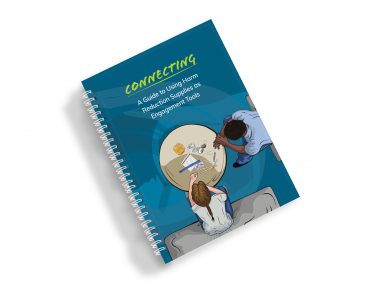Connecting: A new resource for frontline harm reduction workers

“I guess the term ‘quick reference’ is standing out in my mind, like something that’s very, very fast. Because if it’s too wordy I’m not going to have any time ─ something that is like a frequently asked questions kind of thing. A very quick and easy way to get the answer immediately, you know.”
– frontline harm reduction worker in Ontario
When frontline harm reduction staff were asked to describe the most effective resources to support them in their work with people who use drugs, they were clear about what they needed. The Best Practice Recommendations for Canadian Harm Reduction Programs is a great resource, but in its manual form is not very accessible for frontline workers. An ideal resource needs to be easy to access, illustrated, a quick reference guide and in plain language.
So this is what the Ontario Harm Reduction Distribution Program (OHRDP) set out to do, and in April 2021, Connecting: A Guide to Using Harm Reduction Supplies as Engagement Tools was published. Based on the Best Practice Recommendations, the resource supports frontline harm reduction workers in their day-to-day work.
Why and how we started this guide
 Getting harm reduction supplies from community organizations is a commonplace activity for many individuals who use drugs. This interaction can also be the perfect opportunity for frontline workers to begin conversations. Connecting provides tools to support those conversations that can increase a person’s ability to keep themselves safer while minimizing harm to their health.
Getting harm reduction supplies from community organizations is a commonplace activity for many individuals who use drugs. This interaction can also be the perfect opportunity for frontline workers to begin conversations. Connecting provides tools to support those conversations that can increase a person’s ability to keep themselves safer while minimizing harm to their health.
OHRDP led this project in collaboration with the Ontario Harm Reduction Network (OHRN), through secured Public Health Agency of Canada funds. Both OHRDP and OHRN work with large networks of harm reduction programs in Ontario.
In developing this resource, we wanted to:
- Create an educational tool to help harm reduction programs improve their HIV and hepatitis C prevention work through harm reduction supply distribution
- Better understand the needs of frontline workers for educational tools
- Incorporate existing and new research to update the Best Practice Recommendations.
Who contributed to Connecting
Miroslav Miskovic, the project coordinator, has a long history in harm reduction research including working on the Best Practice Recommendations Part 2, and the current review and update of these recommendations. He was aided by numerous people in the harm reduction community who guided this work, such as members of the advisory committee who represent the diverse harm reduction landscape in Ontario. Dr. Carol Strike, the principal author of the original Best Practice Recommendations, was instrumental in providing expertise and guidance.
Connecting was reviewed and evaluated by harm reduction programs throughout the province to make sure that it was relevant to frontline workers. These workers also provided recommendations for additional chapters, such as the disposal of used supplies, the risks associated with using alternate items for injecting/smoking drugs and the use of harm reduction supplies for non-intended purposes. Frontline workers also ensured that illustrations were more reflective of frontline realities.
Sixteen focus groups informed the foundation of the guide and these group meetings took place throughout Ontario, split evenly between eight groups of frontline workers and eight groups of service users from each site. In the sessions with frontline workers, we focused on the distribution of supplies for that community, how training of harm reduction practices is provided and how knowledge of safe practices is shared with service users. In client focus groups, we focused on how individuals access harm reduction supplies and their preferences in obtaining kits and individual supplies. It was also important to learn from service users how they get messaging around safer use of supplies and how they share their knowledge with their harm reduction programs.
What you can find in Connecting
The Connecting guide is broken down into five distinct areas focused on harm reduction supplies available in Ontario:
- safer injecting
- safer inhaling
- safer smoking and snorting
- overdoses
- resources
Each topic area is intended to function alone and support the educational needs of frontline workers so they don’t to have to flip to other sections to find information. Written in a way that allows for a quick read, it features: best practice tips, key messages, scripts, step-by-step guides, as well as a combination of detailed illustrations and photos. It has also been designed so frontline workers could easily share content with service users in the moment, whether they are on outreach or in a needle syringe room.
Get more information
In May 2021, we hosted a webinar to launch the guide. This webinar had a meaningful segment where frontline staff described the ways in which they have been using the resource since they received it. Some of the identified uses include: training of new staff and refresher of safer practices for seasoned folk; educating other internal programs; training and education for external agencies (such as shelters and other services who work with people who use drugs) and being able to review content directly with service users.
The Connecting guide is dedicated to all the individuals who have trusted frontline workers in sharing their experiences. Through these connections and relationships, programs and services continue to evolve. The guide and companion posters are available free for download and are mobile-friendly for outreach workers who may need content on the go.
Denise Beaumont is a team member of the Ontario Harm Reduction Distribution Program. OHRDP coordinates the distribution of harm reduction supplies to core needle syringe programs throughout Ontario and supports these programs with supplies-specific information/education and inventory management practices.
